They don't help much against wild yeast but they are pretty effective against souring ie lactobacillus. That was the main reason for them to be incorporated. Otherwise beer turns sour fairly quickly, which doesn't have to be a bad thing btw.Hops originally went into beer because they were a preservative against spoilage by wild yeasts/bacteria. They may also drop the starting pH a bit (I'm not sure about that).
There are hop resistant strains of yeast and various bacteria (lacto, pedio). In this case, whatever keeps the bucket smelling nice doesn't deal with hops except occasionally, so I don't want to make life too hard on them initially.
If they can't handle hops at all, maybe it'll be good for cider. TBD!
You are using an out of date browser. It may not display this or other websites correctly.
You should upgrade or use an alternative browser.
You should upgrade or use an alternative browser.
Compost bucket sour?
- Thread starter mashdar
- Start date

Help Support Homebrew Talk:
This site may earn a commission from merchant affiliate
links, including eBay, Amazon, and others.
- Joined
- Dec 4, 2021
- Messages
- 416
- Reaction score
- 675
Yeah, as far as I know the main function of hops in a mixed culture beer is to control the growth of lactic acid producing bacteria (LAB). Overall, that should roughly control the acidity of the final beer. The iso-α-acids and some other compounds in hops act against certain bacteria and slow or stop their growth. Mostly they work against gram positive bacteria I think but my knowledge stops there. As far as I know they don't do anything against wild yeasts. I think it gets even more confusing sometimes because the term "spoilage" is used with beer in cases where the beer is still safe to drink but maybe didn't turn out how you wanted. One person might say that Lactobacillus "spoiled" their beer while another person intentionally adds it for the flavor it imparts. Both beers are drinkable, so not necessarily spoiled in the way you'd think with food.I have to admit that I find this experiment sufficiently fascinating that I ordered a copy of this:
https://books.google.com/books/about/Food_Spoilage_Microorganisms.html
I suspect this is going to come down to a question of if something that can drop the pH quickly enough can grow and not taste bad.
One question: why unhopped wort for the starter? I just got back from Brussels (and a tour of Cantillon). They say they use aged hops specifically for anti microbial properties without bitterness. A bit of hopping might give the yeast more of a fighting chance against any nasties.
Bacteria can also be resistant or become resistant over time. So if you don't want LAB to grow out of control and make your beer extremely sour then hopping is the way to do it. I think they do it with aged hops in lambics because they're not looking for the other hop flavors and maybe not as much bitterness either.
If you want more reading then Milk the Funk might be fun for you to browse. They get pretty technical and try to cite references where possible. It's very informative. To start...
https://www.milkthefunk.com/wiki/Lactobacillus
Just did the Cantillon tour last year. It was very fun
mashpaddled
Well-Known Member
For that real terroir of waste you should add trash as a dry garbage addition before packaging.
Brushwood Brewing
Cast your bread upon the waters
- Joined
- May 5, 2022
- Messages
- 208
- Reaction score
- 344
I'm pretty sure hops raise the pH.Hops originally went into beer because they were a preservative against spoilage by wild yeasts/bacteria. They may also drop the starting pH a bit (I'm not sure about that).
According to rando internet search results, you are correct!I'm pretty sure hops raise the pH.
Just transferred for second time. So far:
Gen 1:
I didn't read FG on gen 1. The high FG on gen 2 indicates ~23% apparent attenuation*. This looks like very slow metabolizing of maltose. Presumably limited use of maltotriose and bigger.
Smell was quite tart. A bit like apple cider vinegar, but maybe not all acetic acid. Maybe some cherry and other fruit on the nose. Did not taste. Maybe next generation will get a swish.
No signs of mold so far.
Seems like I might have to add sugars for this stuff to eat if pitching in finished beer?
*there may not be much/any ethanol, so apparent might ~= actual.
edit: Oh, yeah. I realized I pitched gen 2 at ~40F, so that may have delayed growth a bit. Bloops. Gen 3 is ~70F.
Gen 1:
- Lag Time: 48hr
- Gen Time: 6 days
- Final pH: 3.5
- Lag Time: 54hr
- Gen Time: 8 days
- Final pH: 3.3
- FG: 1.028
I didn't read FG on gen 1. The high FG on gen 2 indicates ~23% apparent attenuation*. This looks like very slow metabolizing of maltose. Presumably limited use of maltotriose and bigger.
Smell was quite tart. A bit like apple cider vinegar, but maybe not all acetic acid. Maybe some cherry and other fruit on the nose. Did not taste. Maybe next generation will get a swish.
No signs of mold so far.
Seems like I might have to add sugars for this stuff to eat if pitching in finished beer?
*there may not be much/any ethanol, so apparent might ~= actual.
edit: Oh, yeah. I realized I pitched gen 2 at ~40F, so that may have delayed growth a bit. Bloops. Gen 3 is ~70F.
Last edited:

$20.94
$29.99
The Brew Your Own Big Book of Clone Recipes: Featuring 300 Homebrew Recipes from Your Favorite Breweries
Amazon.com
![Craft A Brew - Safale S-04 Dry Yeast - Fermentis - English Ale Dry Yeast - For English and American Ales and Hard Apple Ciders - Ingredients for Home Brewing - Beer Making Supplies - [1 Pack]](https://m.media-amazon.com/images/I/41fVGNh6JfL._SL500_.jpg)
$6.95 ($17.38 / Ounce)
$7.47 ($18.68 / Ounce)
Craft A Brew - Safale S-04 Dry Yeast - Fermentis - English Ale Dry Yeast - For English and American Ales and Hard Apple Ciders - Ingredients for Home Brewing - Beer Making Supplies - [1 Pack]
Hobby Homebrew

$172.35
2 Inch Tri Clamp Keg Manifold With Ball Lock Posts, Pressure Gauge, PRV (0-30 PSI) – Homebrew, Fermentation, Kegging System
wuhanshijiayangzhiyimaoyiyouxiangongsi

$33.99 ($17.00 / Count)
$41.99 ($21.00 / Count)
2 Pack 1 Gallon Large Fermentation Jars with 3 Airlocks and 2 SCREW Lids(100% Airtight Heavy Duty Lid w Silicone) - Wide Mouth Glass Jars w Scale Mark - Pickle Jars for Sauerkraut, Sourdough Starter
Qianfenie Direct

$33.98
DYKWSWYX Heavy Duty Brewing Gloves (1 Pair) - 55CM Long Chemical Resistant Plastic Gloves for Beer & Wine Making, Cleaning, Homebrew Equipment Protection
wuhanshijiayangzhiyimaoyiyouxiangongsi

$719.00
$799.00
EdgeStar KC2000TWIN Full Size Dual Tap Kegerator & Draft Beer Dispenser - Black
Amazon.com

$53.24
1pc Hose Barb/MFL 1.5" Tri Clamp to Ball Lock Post Liquid Gas Homebrew Kegging Fermentation Parts Brewer Hardware SUS304(Gas MFL)
Guangshui Weilu You Trading Co., Ltd

$58.16
HUIZHUGS Brewing Equipment Keg Ball Lock Faucet 30cm Reinforced Silicone Hose Secondary Fermentation Homebrew Kegging Brewing Equipment
xiangshuizhenzhanglingfengshop

$53.24
1pc Hose Barb/MFL 1.5" Tri Clamp to Ball Lock Post Liquid Gas Homebrew Kegging Fermentation Parts Brewer Hardware SUS304(Liquid Hose Barb)
yunchengshiyanhuqucuichendianzishangwuyouxiangongsi

$22.00 ($623.23 / Ounce)
AMZLMPKNTW Ball Lock Sample Faucet 30cm Reinforced Silicone Hose Secondary Fermentation Homebrew Kegging joyful
无为中南商贸有限公司

$176.97
1pc Commercial Keg Manifold 2" Tri Clamp,Ball Lock Tapping Head,Pressure Gauge/Adjustable PRV for Kegging,Fermentation Control
hanhanbaihuoxiaoshoudian

$76.92 ($2,179.04 / Ounce)
Brewing accessories 1.5" Tri Clamp to Ball Lock Post Liquid Gas Homebrew Kegging Fermentation Parts Brewer Hardware SUS304 Brewing accessories(Gas Hose Barb)
chuhanhandianzishangwu

$479.00
$559.00
EdgeStar KC1000SS Craft Brew Kegerator for 1/6 Barrel and Cornelius Kegs
Amazon.com

$49.95 ($0.08 / Fl Oz)
$52.99 ($0.08 / Fl Oz)
Brewer's Best - 1073 - Home Brew Beer Ingredient Kit (5 gallon), (Blueberry Honey Ale) Golden
Amazon.com

$7.79 ($7.79 / Count)
Craft A Brew - LalBrew Voss™ - Kveik Ale Yeast - For Craft Lagers - Ingredients for Home Brewing - Beer Making Supplies - (1 Pack)
Craft a Brew

$44.99
$49.95
Craft A Brew - Mead Making Kit – Reusable Make Your Own Mead Kit – Yields 1 Gallon of Mead
Craft a Brew
After some more reading, could the high FG be because the pH got so low? I've been reading that lactobacillus and pediococcus tend to drop pH to about 3.5 and then stall out.
Perhaps it will eat longer polysaccharides if it has to and pH is higher?
Perhaps it will eat longer polysaccharides if it has to and pH is higher?
- Joined
- Dec 4, 2021
- Messages
- 416
- Reaction score
- 675
I can definitely confirm that's how LAB acts in a lacto ferment. Especially running it at 70F. If you run it hot then it can drop to 3.5 pH within a couple days. If your culture is lacto and pedio heavy then this seems possible to me. I think the working pH range for most brewers yeast goes down to around 4 pH. So whatever isn't lacto or pedio in there could be struggling.After some more reading, could the high FG be because the pH got so low? I've been reading that lactobacillus and pediococcus tend to drop pH to about 3.5 and then stall out.
Perhaps it will eat longer polysaccharides if it has to and pH is higher?
One thought would be to split it at some point and do a test. Pull 5% and hop it and then pull another 5% and carry on as usual. See how each behaves. If you want then you can blend them back together down the line.
Last edited:
You're doing a wild, mixed fermentation. There's a reason why lambic takes so much time to ferment and why they add aged hops. The time is needed to let it ferment out and the hops to control the sourness. They also add specific precursors of some tastes that the yeast will make out of it.After some more reading, could the high FG be because the pH got so low? I've been reading that lactobacillus and pediococcus tend to drop pH to about 3.5 and then stall out.
Perhaps it will eat longer polysaccharides if it has to and pH is higher?
Don't look much at the gravity, it will very likely continue to drop over the next year. Yes, wild fermentation really needs that time.
Curious. Is the primary mode of action inhibition of growth, buffering, or forcing some alternate metabolics? Seems like buffering would run out fast, so maybe it just gives yeast time to eat first?hops to control the sourness.
Batch 3 is already covered with a pelicle (32 hrs) and bubbling a little more than past batches. I see more of what looks like floc'd yeast this time around.
edit: Also, I've been pressure canning the starters. What do you think about throwing a few t90 pellets in? I imagine AA would isomerize at 240F, but this is new territory lol
Most of the lactic acid bacteria are highly intolerant to hops. So by adding "weakened" (aged) hops, they are not completely eliminated, not their number and replication is heavily suppressed.Curious. Is the primary mode of action inhibition of growth, buffering, or forcing some alternate metabolics? Seems like buffering would run out fast, so maybe it just gives yeast time to eat first?
Batch 3 is already covered with a pelicle (32 hrs) and bubbling a little more than past batches. I see more of what looks like floc'd yeast this time around.
edit: Also, I've been pressure canning the starters. What do you think about throwing a few t90 pellets in? I imagine AA would isomerize at 240F, but this is new territory lol
- Joined
- Dec 4, 2021
- Messages
- 416
- Reaction score
- 675
I can't find any research for hops that directly relates, but it seems like other organic compounds either don't show an effect of pressure on isomerization or the isomerization effect is only partially reduced. I think you'll be fine throwing in a few T90s.Curious. Is the primary mode of action inhibition of growth, buffering, or forcing some alternate metabolics? Seems like buffering would run out fast, so maybe it just gives yeast time to eat first?
Batch 3 is already covered with a pelicle (32 hrs) and bubbling a little more than past batches. I see more of what looks like floc'd yeast this time around.
edit: Also, I've been pressure canning the starters. What do you think about throwing a few t90 pellets in? I imagine AA would isomerize at 240F, but this is new territory lol
@Miraculix seems right to me. If I understand correctly, the iso alpha acids basically react with the LAB to reduce their number in the beer. Killing them, stunting them...I'm not sure. Enough hops or hops with a high enough alpha...that reduction can become functionally elimination, though. Lower alpha also gives you more room for error when working with beer. Too much or too little with a high alpha hop and it could really, really matter in this case. Not so much with low alpha.
Batch 3
How low can pH go?? I'll re-calibrate meter before next reading as a sanity check.
I tasted (and spit) some! It was surprisingly like apple cider. Very fruity, no acetic acid.
- Lag Time: 8 hr
- Gen Time: 7 days
- Final pH: 3.2
- FG: 1.022
How low can pH go?? I'll re-calibrate meter before next reading as a sanity check.
I tasted (and spit) some! It was surprisingly like apple cider. Very fruity, no acetic acid.
- Joined
- Dec 4, 2021
- Messages
- 416
- Reaction score
- 675
Thanks for the updates. Really interesting! As for pH, that's low but not an impossible measurement in this situation. These people checked 9 lambics and the pH ranged from about 3.2 - 3.6.Batch 3
It's getting accustomed to it's new home. Looked like more yeast this time around. Lots more bubbles even on day 7.
- Lag Time: 8 hr
- Gen Time: 7 days
- Final pH: 3.2
- FG: 1.022
How low can pH go?? I'll re-calibrate meter before next reading as a sanity check.
I tasted (and spit) some! It was surprisingly like apple cider. Very fruity, no acetic acid.
https://www.mdpi.com/2306-5710/3/4/51
They cite an older paper that has a nice graphic tracking alcohol, gravity, and pH for lambics over 24 months (see Fig 2). It shows an initial fermentation that took the gravity down to around 1.022 and pH around 4 after a few months. Then the gravity drops another 10 point and the pH drops to about 3 over time.
https://onlinelibrary.wiley.com/doi/pdf/10.1002/j.2050-0416.1975.tb06953.x
I'd expect your trajectory here to be different for multiple reasons, but it's not beyond belief!
Life made me skip a weekly propagation.
Batch 4:
Batch 5 is split into hopped (5H) and un-hopped (5X). I hopped 750ml of 1.036 wort with 0.6g of 4.5%AA T90 Fuggles. It went through the pressure cooker, so hours at 212F+. This is roughly 1/2oz in a 5 gallon batch.
At day 5, I cannot tell much of a difference between batch 5H and 5X. 5H may be bubbling slightly slower, but that may just be the shape of the glass or the way it's sitting. Surface bubbles appear similar, which is probably a more accurate integrator of bubble activity.
unhopped batch 5X: .................................................. hopped batch 5H:


For 6H, I'll probably do 2g~ of hops to see if that has more of an effect.
Batch 4:
- Lag Time: 8hr
- Gen Time: 13 days
- Final pH: 3.3
- FG: Disaster! Forgot to measure.
Batch 5 is split into hopped (5H) and un-hopped (5X). I hopped 750ml of 1.036 wort with 0.6g of 4.5%AA T90 Fuggles. It went through the pressure cooker, so hours at 212F+. This is roughly 1/2oz in a 5 gallon batch.
At day 5, I cannot tell much of a difference between batch 5H and 5X. 5H may be bubbling slightly slower, but that may just be the shape of the glass or the way it's sitting. Surface bubbles appear similar, which is probably a more accurate integrator of bubble activity.
unhopped batch 5X: .................................................. hopped batch 5H:


For 6H, I'll probably do 2g~ of hops to see if that has more of an effect.
Nice! Keep it going and keep us posted!Life made me skip a weekly propagation.
Batch 4:
Tasted batch 4, also very much like cider, perhaps slightly smoother acidity. I calibrated the pH meter this time. Before and after values were the same, so it looks like it hadn't drifted much.
- Lag Time: 8hr
- Gen Time: 13 days
- Final pH: 3.3
- FG: Disaster! Forgot to measure.
Batch 5 is split into hopped (5H) and un-hopped (5X). I hopped 750ml of 1.036 wort with 0.6g of 4.5%AA T90 Fuggles. It went through the pressure cooker, so hours at 212F+. This is roughly 1/2oz in a 5 gallon batch.
At day 5, I cannot tell much of a difference between batch 5H and 5X. 5H may be bubbling slightly slower, but that may just be the shape of the glass or the way it's sitting. Surface bubbles appear similar, which is probably a more accurate integrator of bubble activity.
unhopped batch 5X: .................................................. hopped batch 5H:
View attachment 850651View attachment 850652
For 6H, I'll probably do 2g~ of hops to see if that has more of an effect.
- Joined
- Dec 4, 2021
- Messages
- 416
- Reaction score
- 675
Seconding that! I was just thinking about bumping the thread to see how it's going. Glad to see the updates and looking forward to more.Nice! Keep it going and keep us posted!
Batch 5X: (0g hops in 750ml 1.036 wort)
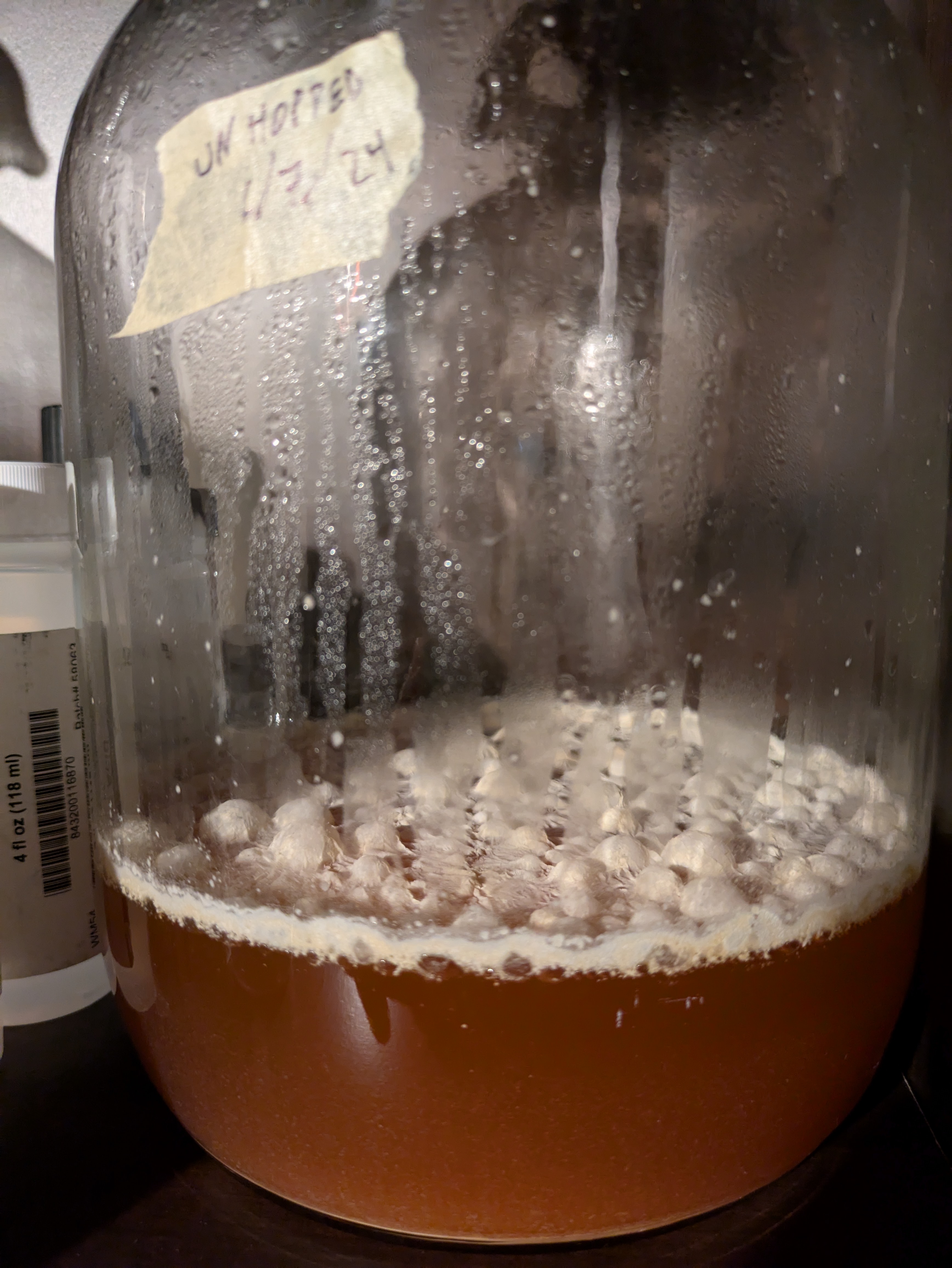
Batch 5H (0.6g 4.5%AA Fuggles in 750ml 1.036 wort)
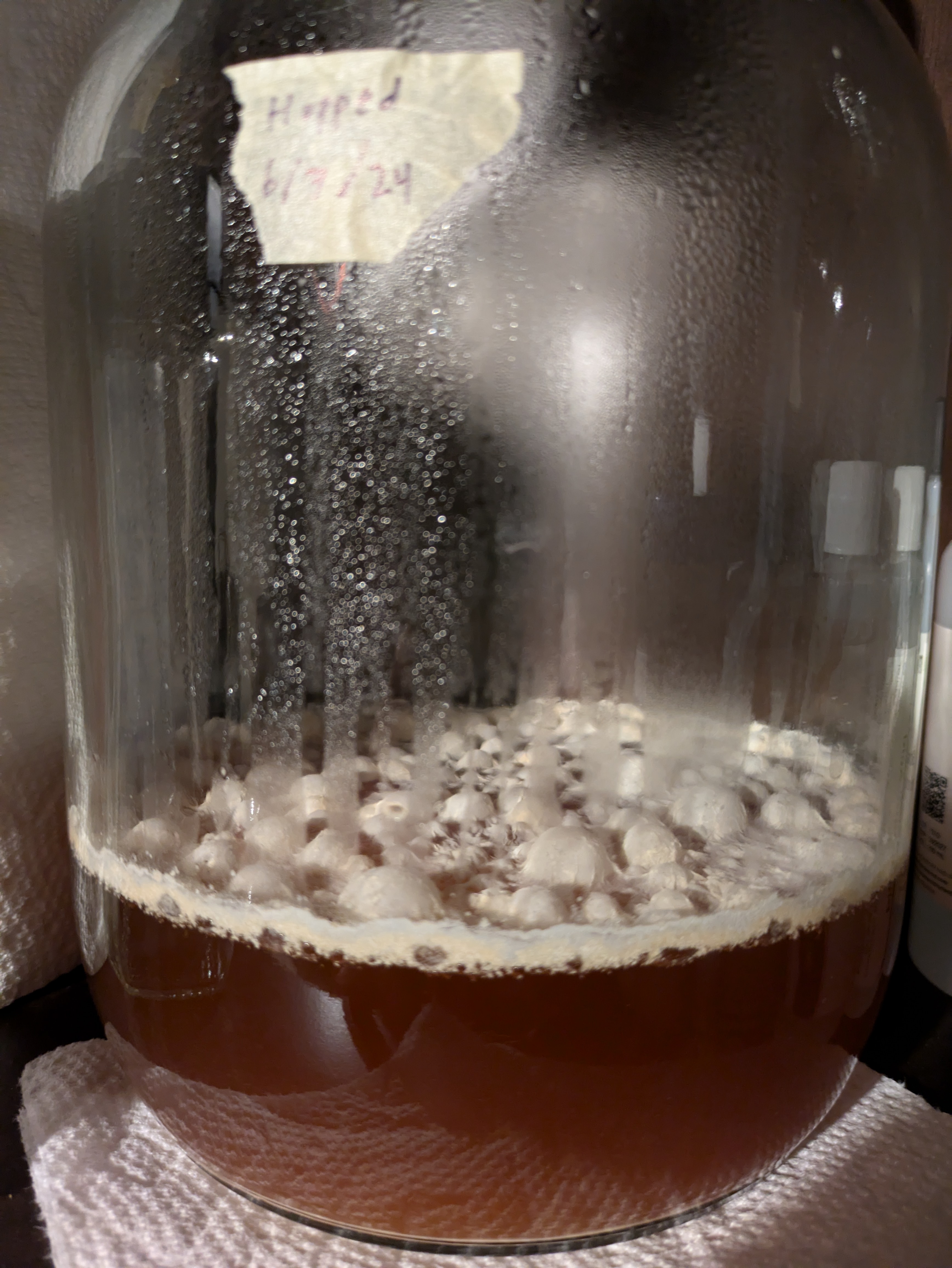
From here on batch #H will be propagated from (#-1)H, and #X from (#-1)X.
Batch #6H is set up with 2.1g hops in 750ml starter. I may have jumped the gun on the hopping regimen -- clearly it had more effect than I could tell visually. Very interesting!
- Lag Time: 8hr~
- Gen Time: 10 days
- Final pH: 3.3
- FG: 1.013

Batch 5H (0.6g 4.5%AA Fuggles in 750ml 1.036 wort)
- Lag Time: 8hr~
- Gen Time: 10 days
- Final pH: 3.9
- FG: 1.009

From here on batch #H will be propagated from (#-1)H, and #X from (#-1)X.
Batch #6H is set up with 2.1g hops in 750ml starter. I may have jumped the gun on the hopping regimen -- clearly it had more effect than I could tell visually. Very interesting!
Last edited:
Just tasted.
5X was unfortunately the first batch with an acetic character. Not too bad, but definitely there. Also a bit "footy". I think there is some wild yeast at work with a wild flavor.
5H was... surprisingly boring. Almost just low-flavor beer. Slightly funky foot. The hop bitterness was present -- hopefully 2.1g isn't extreme overkill.
Also worth noting: I had been generating starters in 1qt canning jars and pitching into 1 gallon demijohns. I'm keeping the starters the same, but pitching into 2qt canning jars from now on because I needed more containers, and felt like 3+:1 head space was excessive.
5X was unfortunately the first batch with an acetic character. Not too bad, but definitely there. Also a bit "footy". I think there is some wild yeast at work with a wild flavor.
5H was... surprisingly boring. Almost just low-flavor beer. Slightly funky foot. The hop bitterness was present -- hopefully 2.1g isn't extreme overkill.
Also worth noting: I had been generating starters in 1qt canning jars and pitching into 1 gallon demijohns. I'm keeping the starters the same, but pitching into 2qt canning jars from now on because I needed more containers, and felt like 3+:1 head space was excessive.
Why do I keep reading this thread? It's like watching a herd of deer being squished by a fleet of motorcycles...
I was thinking the same thing. And I can’t stop following.Why do I keep reading this thread? It's like watching a herd of deer being squished by a fleet of motorcycles...
@mashdar when do we get to “beer”?
Well, if the experts can be believed, at some point it needs to go in real beer and sit for a year to see what happens? I'll probably do a split batch soon.
Next beer is a small porter, so probably not that one.
What kind of beer do you guys think it should go in? Something big? Dark? Aged hops?
Depends on your aims. I would try something very simple, a highly fermentable smash with about twenty ibus.Well, if the experts can be believed, at some point it needs to go in real beer and sit for a year to see what happens? I'll probably do a split batch soon.
Next beer is a small porter, so probably not that one.
What kind of beer do you guys think it should go in? Something big? Dark? Aged hops?
If you want to go the full lambic route, you'd need almost zero ibus plus aged hops.
- Joined
- Dec 4, 2021
- Messages
- 416
- Reaction score
- 675
What kind of beer do you guys think it should go in? Something big? Dark? Aged hops?
Yeah, agreed with something simple. I just did a blonde/golden sour and decided to do 100% English Pale Malt. It turned out extremely well! Just over 6% and just enough malt profile to be interesting. I say try aged hops and lean into the funk, but that's my tasteDepends on your aims. I would try something very simple, a highly fermentable smash with about twenty ibus.
If you want to go the full lambic route, you'd need almost zero ibus plus aged hops.
https://yakimavalleyhops.com/products/lambic-hop-pellets
Apologies for the long delay! Even though I had two starters in the fridge, work/life prevented propagation for a while.
Batch 6X: (0g hops in 750ml 1.036 wort)
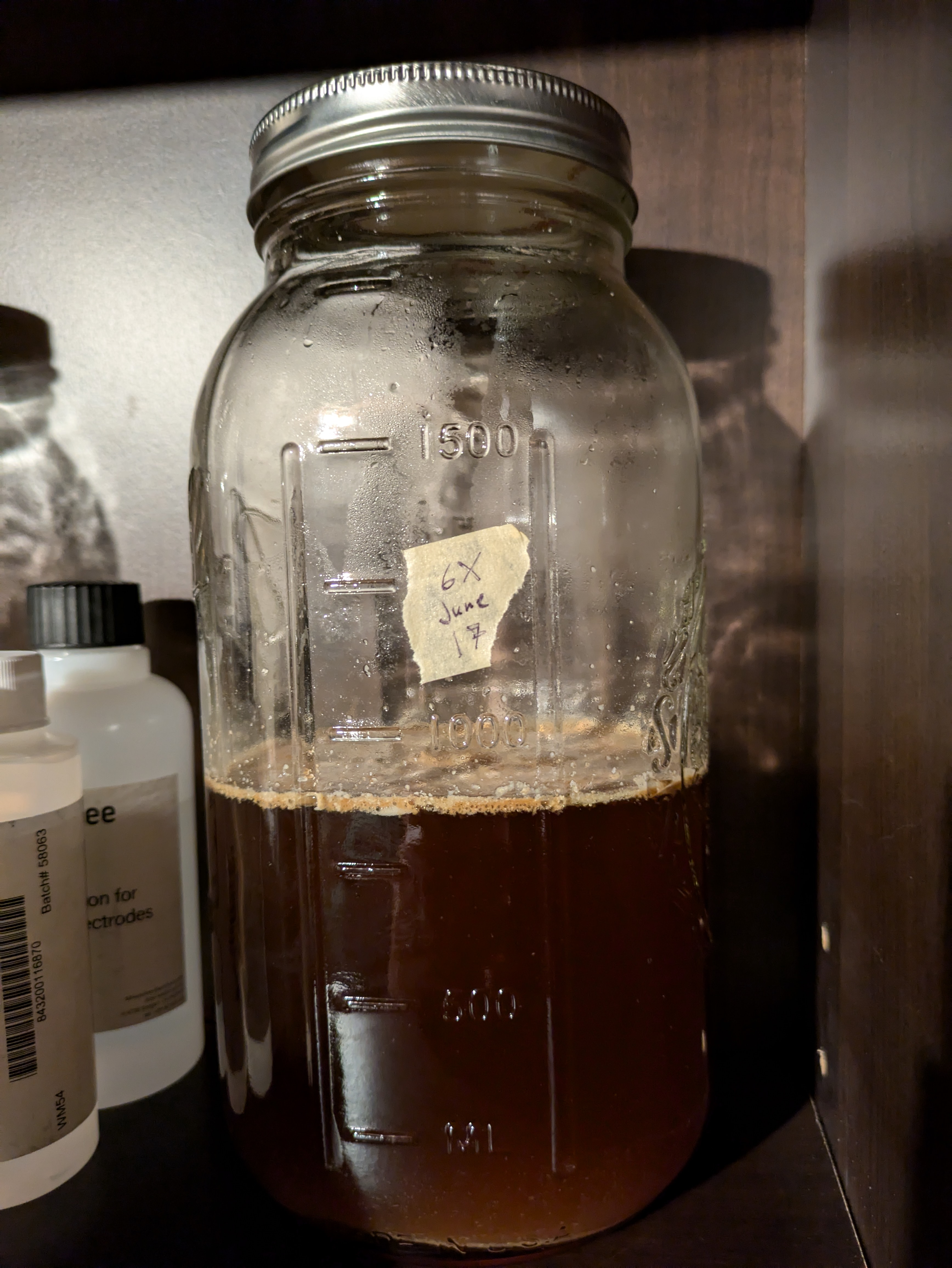
Batch 6H (1.8g 4.5%AA Fuggles in 750ml 1.036 wort)
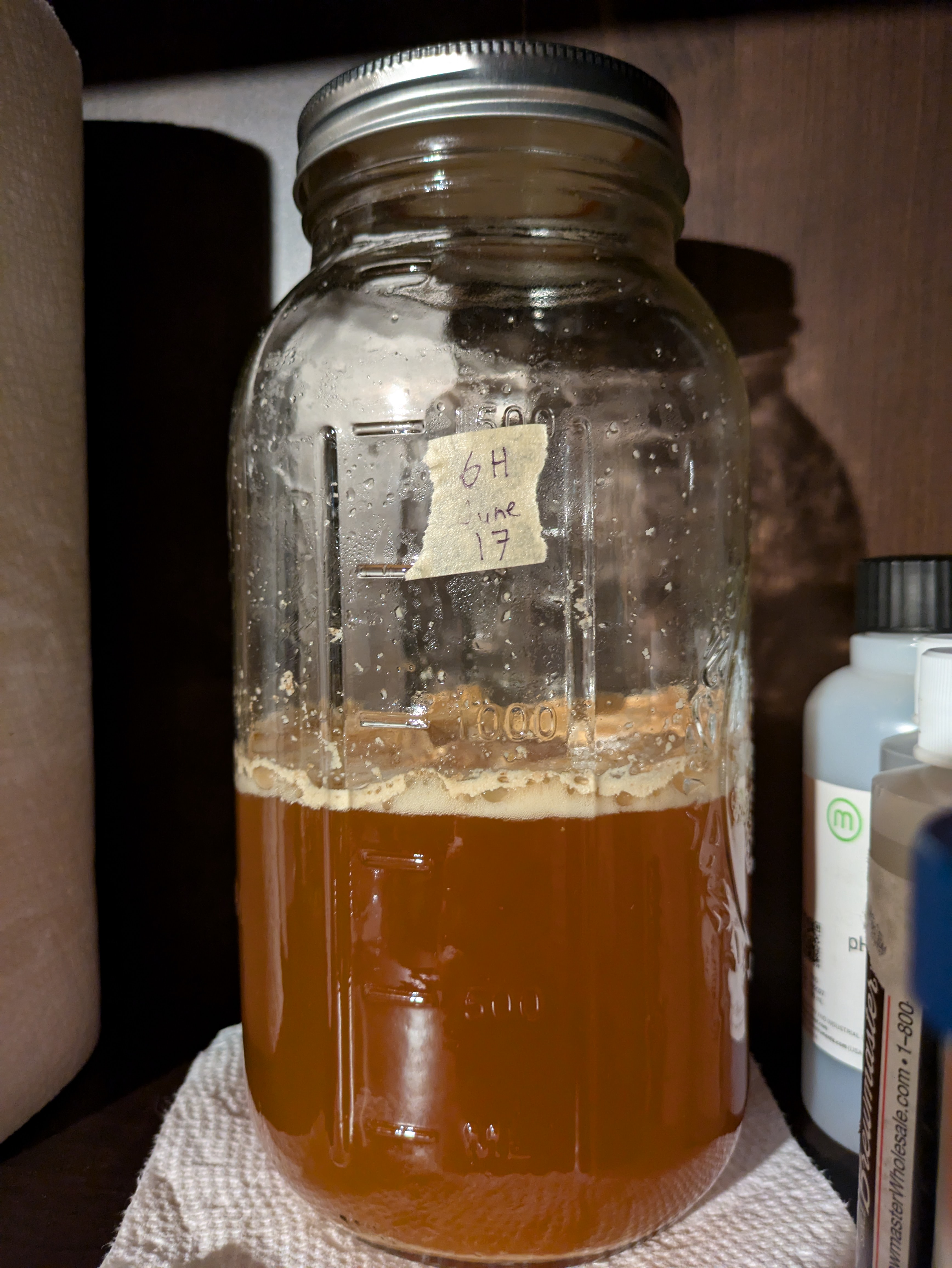
General thoughts:
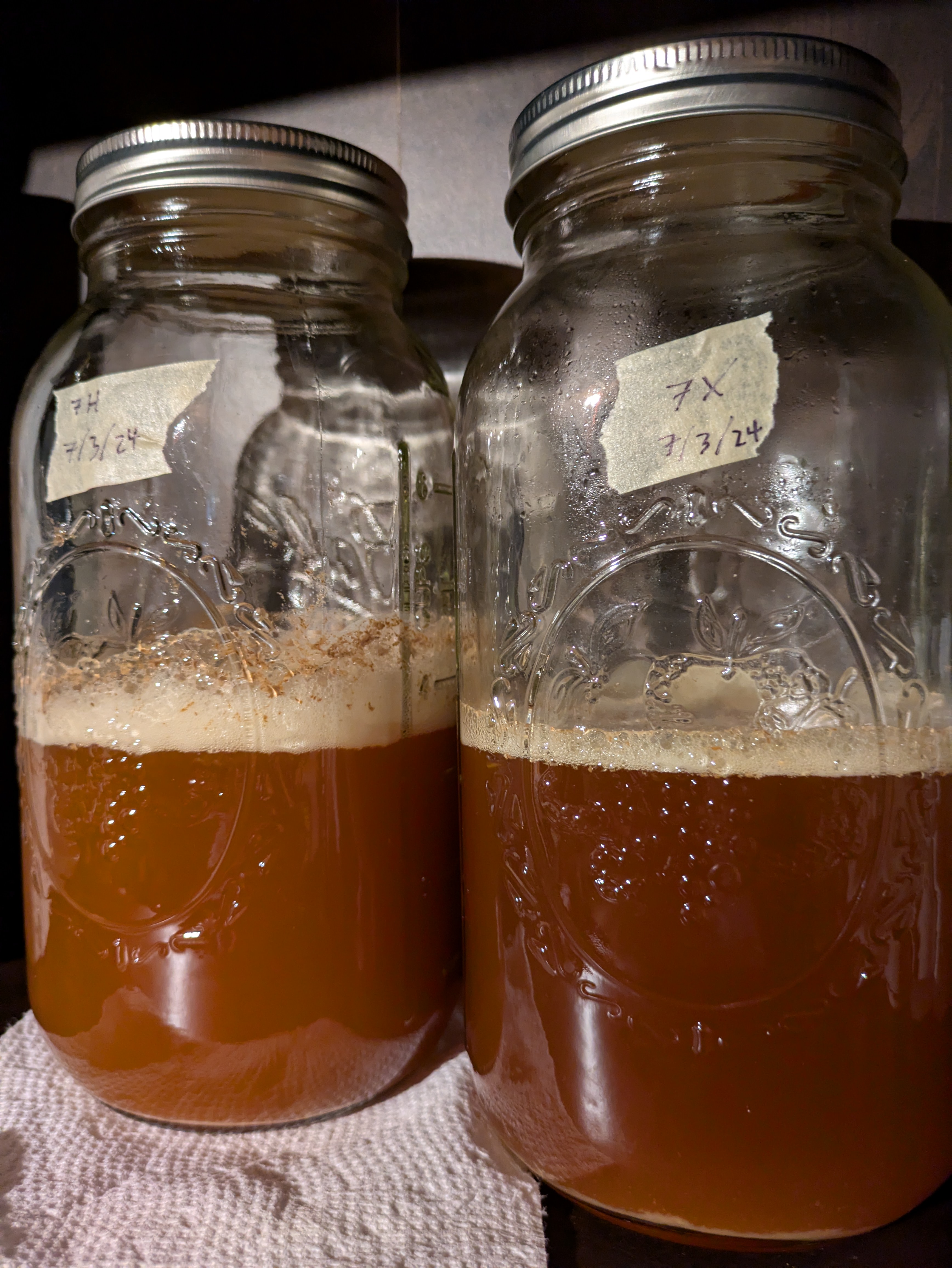
edit: added photos to previous batch post
Batch 6X: (0g hops in 750ml 1.036 wort)
- Lag Time: 8hr~
- Gen Time: 16 days
- Observations: Produced krausen! A little slower than 6H (bubbled for longer). If you look at the photos, you'll note that this 6X is darker than 6H. This was a pressure-cooked starter from the previous batch, and sat at higher temperatures longer.
- Final pH: 3.2
- FG: 1.010
- Tasting notes: Fruity. Acetic character is gone. Tart. This was actually pleasant to taste.

Batch 6H (1.8g 4.5%AA Fuggles in 750ml 1.036 wort)
- Lag Time: 8hr~
- Gen Time: 16 days
- Observations: Produced krausen! Fermentation mostly done by 3 days post-pitch.
- Final pH: 3.9
- FG: 1.011
- Tasting notes: This actually tasted like extremely over-bittered normal beer. The final gravity being higher than the no-hop version is interesting. Likely the no-hop version has achieved yeast dominance early and this version inhibits LAB so hard that this one finishes and the other one acidifies a bit more.

General thoughts:
- Pressure cooking appears to isomerize hopes beyond normal limits. Quite bitter.
- TBH the unhopped mix is turning out quite nicely. The hopped version might be too boring. This may be a product of the relatively fast propagation cycles.
- 7H finished active fermentation in ~36 hours. 7H and 7X both formed even stronger krausen than before. 7X is still bubbling away.

edit: added photos to previous batch post
Last edited:
Looks like you grew yourself some brewers yeast! Congratulations!Apologies for the long delay! Even though I had two starters in the fridge, work/life prevented propagation for a while.
Batch 6X: (0g hops in 750ml 1.036 wort)
View attachment 852479
- Lag Time: 8hr~
- Gen Time: 16 days
- Observations: Produced krausen! A little slower than 6H (bubbled for longer). If you look at the photos, you'll note that this 6X is darker than 6H. This was a pressure-cooked starter from the previous batch, and sat at higher temperatures longer.
- Final pH: 3.2
- FG: 1.010
- Tasting notes: Fruity. Acetic character is gone. Tart. This was actually pleasant to taste.
Batch 6H (1.8g 4.5%AA Fuggles in 750ml 1.036 wort)
View attachment 852480
- Lag Time: 8hr~
- Gen Time: 16 days
- Observations: Produced krausen! Fermentation mostly done by 3 days post-pitch.
- Final pH: 3.9
- FG: 1.011
- Tasting notes: This actually tasted like extremely over-bittered normal beer. The final gravity being higher than the no-hop version is interesting. Likely the no-hop version has achieved yeast dominance early and this version inhibits LAB so hard that this one finishes and the other one acidifies a bit more.
General thoughts:
View attachment 852481
- Pressure cooking appears to isomerize hopes beyond normal limits. Quite bitter.
- TBH the unhopped mix is turning out quite nicely. The hopped version might be too boring. This may be a product of the relatively fast propagation cycles.
- 7H finished active fermentation in ~36 hours. 7H and 7X both formed even stronger krausen than before. 7X is still bubbling away.
edit: added photos to previous batch post
Batch 7X: (0g hops in 750ml 1.036 wort)
- Lag Time: <18h (first check)
- Gen Time: 25 days
- Observations: Krausen again. A little slower than 7H (bubbled for longer).
- Final pH: 3.2
- FG: 1.009
- Tasting notes: Fruity. Very light acetic character. Tart. Fruit this time was a little wierd - fruit punch and pineapple. A little less nice than last generation.
- Lag Time: <18h (first check)
- Gen Time: 25 days
- Observations: Krausen, again. Fermentation mostly done by 3 days post-pitch.
- Final pH: 3.8
- FG: 1.010
- Tasting notes: The aroma on this had a lot more fruity/sour to it this go around. Only slightly lower pH, and still didn't seem tart, but nose was very similar to the no-hop version. Taste was still fairly boring, with a strong hop bitter after taste.
- This was the last of the high-dose hopping. Now they will go back to 0.6g.
Last edited:
I have good news and bad news.
The good news, is there's a beer fermenting, using culture 8X as a LAB starter! It's in the style of a historical Berliner Weisse (unhopped, 1.029 OG, hot sparge). In theory it should be drinkable relatively soon, as I'm not striving for a bunch of brett.
At pitch:
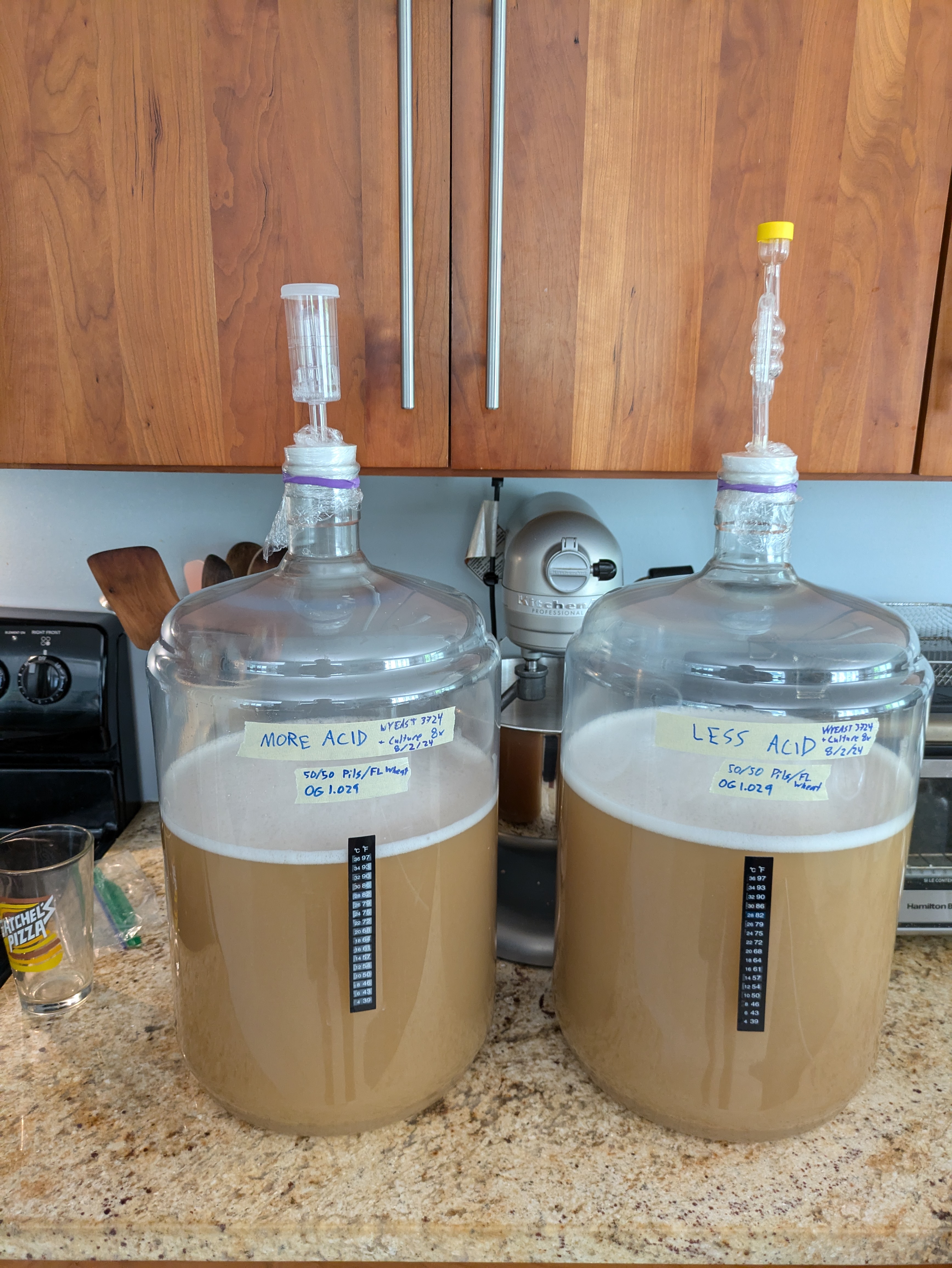
Active 6 hours later!
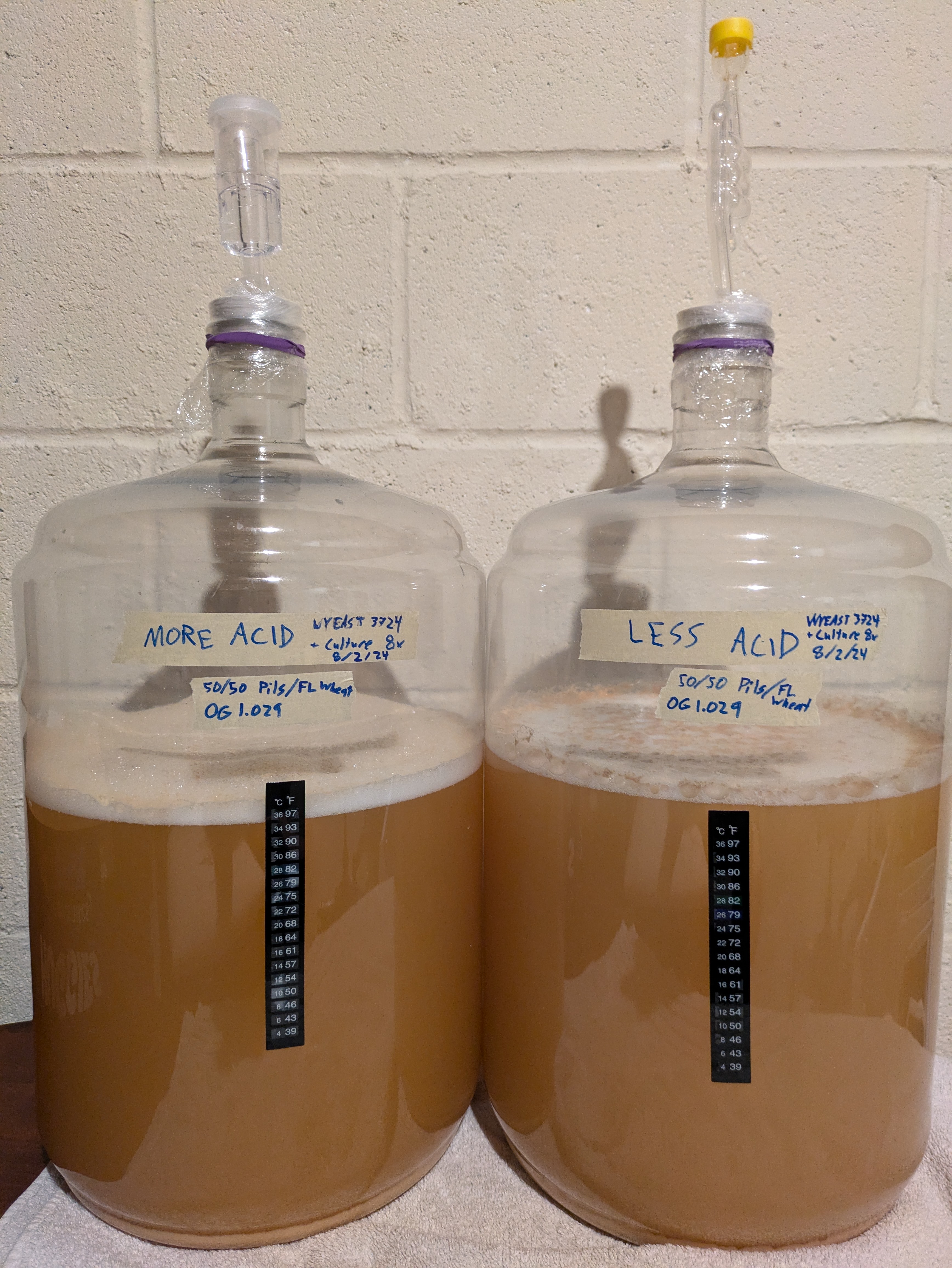
And now the bad news. I poured ~75% of sour starter 8X into one fermenter, and ~15% into the other fermenter. Then I poured the rest down the sink. Then I thought "Oh, I should have saved that for a PH/gravity reading". Then I though "OH $$$$". The lineage of unhopped sour starter has ended.
I have three options to resume:
The good news, is there's a beer fermenting, using culture 8X as a LAB starter! It's in the style of a historical Berliner Weisse (unhopped, 1.029 OG, hot sparge). In theory it should be drinkable relatively soon, as I'm not striving for a bunch of brett.
At pitch:

Active 6 hours later!

And now the bad news. I poured ~75% of sour starter 8X into one fermenter, and ~15% into the other fermenter. Then I poured the rest down the sink. Then I thought "Oh, I should have saved that for a PH/gravity reading". Then I though "OH $$$$". The lineage of unhopped sour starter has ended.
I have three options to resume:
- Start a new culture from the bucket. Time intensive, but will likely work fine. Chance of a slightly different population, but the bucket is likely somewhat stable given its long history of not molding/smelling. (We just went on vacation for 10 days and I left the bucket full in an 80F house. No mold, no stink when we got back!)
- Propagate the hopped starter as unhopped. This might return to a similar state as the former culture, although we're 4 hopped generations in, which would be asking a lot of any bacteria that can't handle hops.
- Use the "more acid" Berliner Weisse as generation 9X. The up side to this is that the unhopped LAB culture is probably ~100% in tact. The down side is it'll be forever tainted with Wyeast 3724.
Last edited:
Number one!I have good news and bad news.
The good news, is there's a beer fermenting, using culture 8X as a LAB starter! It's in the style of a historical Berliner Weiss (unhopped, 1.029 OG, hot sparge). In theory it should be drinkable relatively soon, as I'm not striving for a bunch of brett.
At pitch:
View attachment 854657
Active 6 hours later!
View attachment 854658
And now the bad news. I poured ~75% of sour starter 8X into one fermenter, and ~15% into the other fermenter. Then I poured the rest down the sink. Then I thought "Oh, I should have saved that for a PH/gravity reading". Then I though "OH $$$$". The lineage of unhopped sour starter has ended.
I have three options to resume:
I think I'm leaning towards option #3. If the yeast survives, it'll just be part of the gang. But there's a chance that storing it for a month every generation at 3.2pH will kill all the 3724 anyway.
- Start a new culture from the bucket. Time intensive, but will likely work fine. Chance of a slightly different population, but the bucket is likely somewhat stable given its long history of not molding/smelling. (We just went on vacation for 10 days and I left the bucket full in an 80F house. No mold, no stink when we got back!)
- Propagate the hopped starter as unhopped. This might return to a similar state as the former culture, although we're 4 hopped generations in, which would be asking a lot of any bacteria that can't handle hops.
- Use the "more acid" Berliner Weiss as generation 9X. The up side to this is that the unhopped LAB culture is probably ~100% in tact. The down side is it'll be forever tainted with Wyeast 3724.
Done! I had just cleaned the bucket and canned 3x starters yesterday, so I guess this is the time to do it.Number one!
I would do #3 also.
Yep! I'd also do that one too!I would do #3 also.
Ok - I've got the jars etc. Maybe I'll do all three and compare them after 3-4 generations.
Pellicle on 9X (fresh inoculation from bucket) is remarkably similar to batch 1. The basement is ~10F warmer, so it's progressing a little faster. At 36 hours, two types of pellicle are forming: a milky white one and a thinner one.
9Y will be 8H propagated into unhopped, and 9Z will be the weisse propagated.
9Y will be 8H propagated into unhopped, and 9Z will be the weisse propagated.
Last edited:
Beer update!
I transferred the 17-day-old beers into kegs today. I did my "old school" star-san purge + non-closed transfer into the liquid dip tube with the PRV open. Not as perfect as my closed loop transfers these days, but it went smoothly.
I took readings and tasted the mostly flat, 75F beer.
More Acid:
Less Acid
I was thinking I would age it in the keg for a prolonged period, but I may bottle half now for consumption in the next few months.
Also: I pitched starter 10Y from the More Acid yeast cake.
edit: added photos
Pre-Transfer:
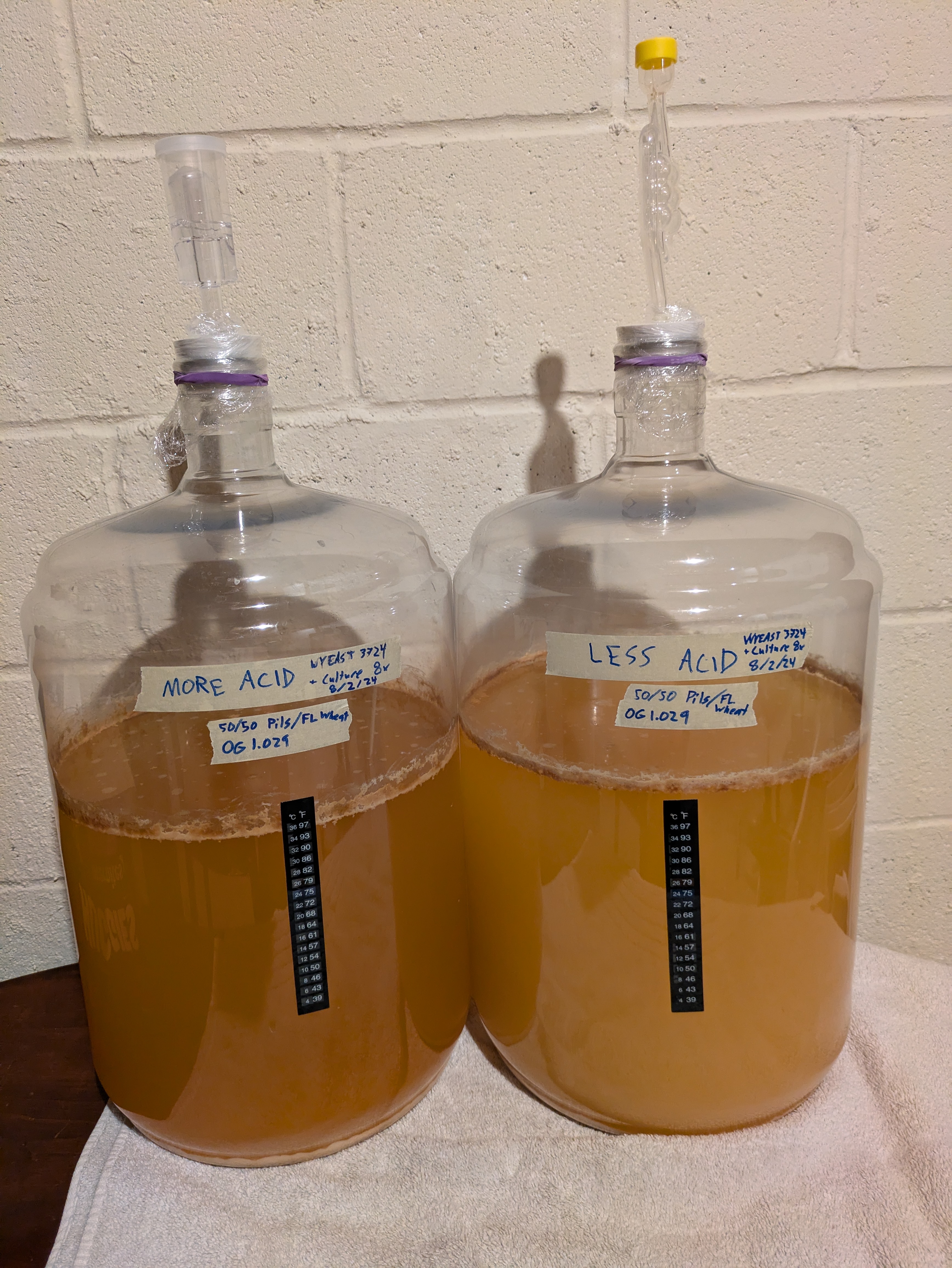
Post-Transfer
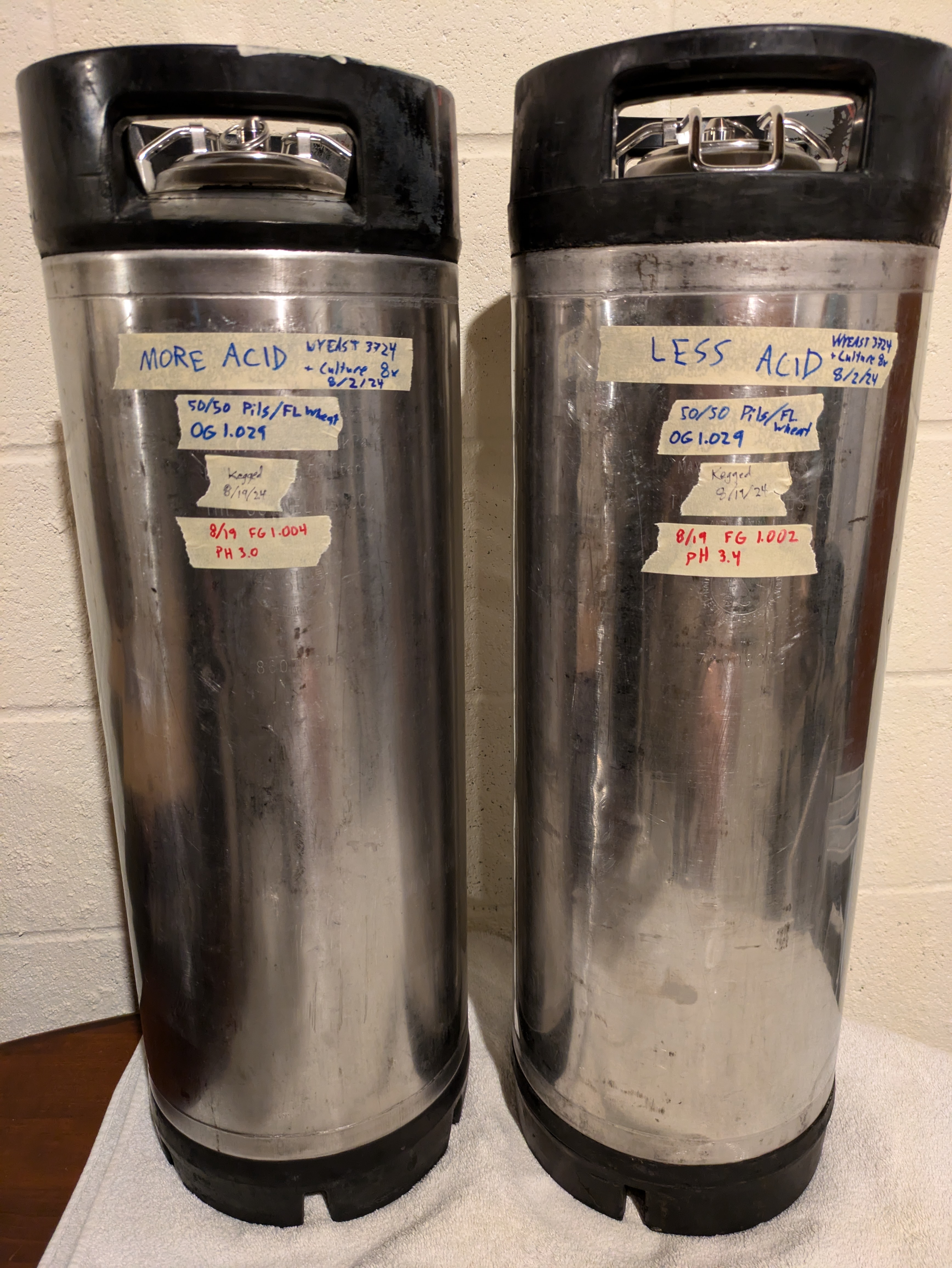
I transferred the 17-day-old beers into kegs today. I did my "old school" star-san purge + non-closed transfer into the liquid dip tube with the PRV open. Not as perfect as my closed loop transfers these days, but it went smoothly.
I took readings and tasted the mostly flat, 75F beer.
More Acid:
- pH = 3.0 (!)
- FG(?) = 1.004
- Smell: Kind of smelled like a tart saison. (Recall that I was using the 3724 dupont)
- Taste: Quite tart. It would be hard to drink a whole pint of this plain. I'll have to look into syrups! It was not acetic. If anything, it was pretty mild other than the acidity.
- General Notes: I think I would call this a success. However, looking at the effort involved vs just buying a known culture, probably not worth it lol
Less Acid
- pH = 3.4
- FG(?) = 1.002
- Smell: Smelled like a saison.
- Taste: Wow. I'm sure side-by-side this would be more tart than yeast-only saison, but after tasting the more-acid beer, I got slightly acidic saison with a nice grain flavor. Actually a delightful beer.
- General notes: Similar to the starters, FG was lower than the more acidic version. I suspect the very low pH of the other version was inhibiting the yeast metabolizing the last available food.
I was thinking I would age it in the keg for a prolonged period, but I may bottle half now for consumption in the next few months.
Also: I pitched starter 10Y from the More Acid yeast cake.
edit: added photos
Pre-Transfer:

Post-Transfer

Last edited:
I've been pretty slow to propagate, and the wide mouth jars may be letting too much air in - they haven't smelled great for the last two batches.
Batch 8X: (0g hops in 750ml 1.036 wort)
I'm thinking I may retire the hopped version, and focus on propagating more frequently in smaller batches to make it more convenient.
Batch 8X: (0g hops in 750ml 1.036 wort)
- Lag Time: 24h
- Gen Time: 34 days
- Final pH: 3.1
- FG: 1.013
- Did not taste. Did not smell great. Likely too much O2 exposure.
- Lag Time: 12h
- Gen Time: 19 days
- Final pH: 3.1
- FG: 1.008
- Did not taste. Did not smell great. Likely too much O2 exposure.
- Lag Time: 18h
- Gen Time: 25 days
- Final pH: 4.1
- FG: 1.015
- Did not taste. Did not smell great. Likely too much O2 exposure.
- Lag Time: 30h
- Gen Time: 35 days
- Final pH: 3.3
- FG: 1.012
- Did not taste. Did not smell great. Likely too much O2 exposure.
- Lag Time: 30h
- Gen Time: 35 days
- Final pH: 3.3
- FG: 1.006
- Did not taste. Did not smell great. Likely too much O2 exposure.
- Lag Time: 30h
- Gen Time: 35 days
- Final pH: 3.5
- FG: 1.018
- Did not taste. Did not smell great. Likely too much O2 exposure.
I'm thinking I may retire the hopped version, and focus on propagating more frequently in smaller batches to make it more convenient.
Similar threads
- Replies
- 39
- Views
- 1K
- Replies
- 8
- Views
- 1K









































